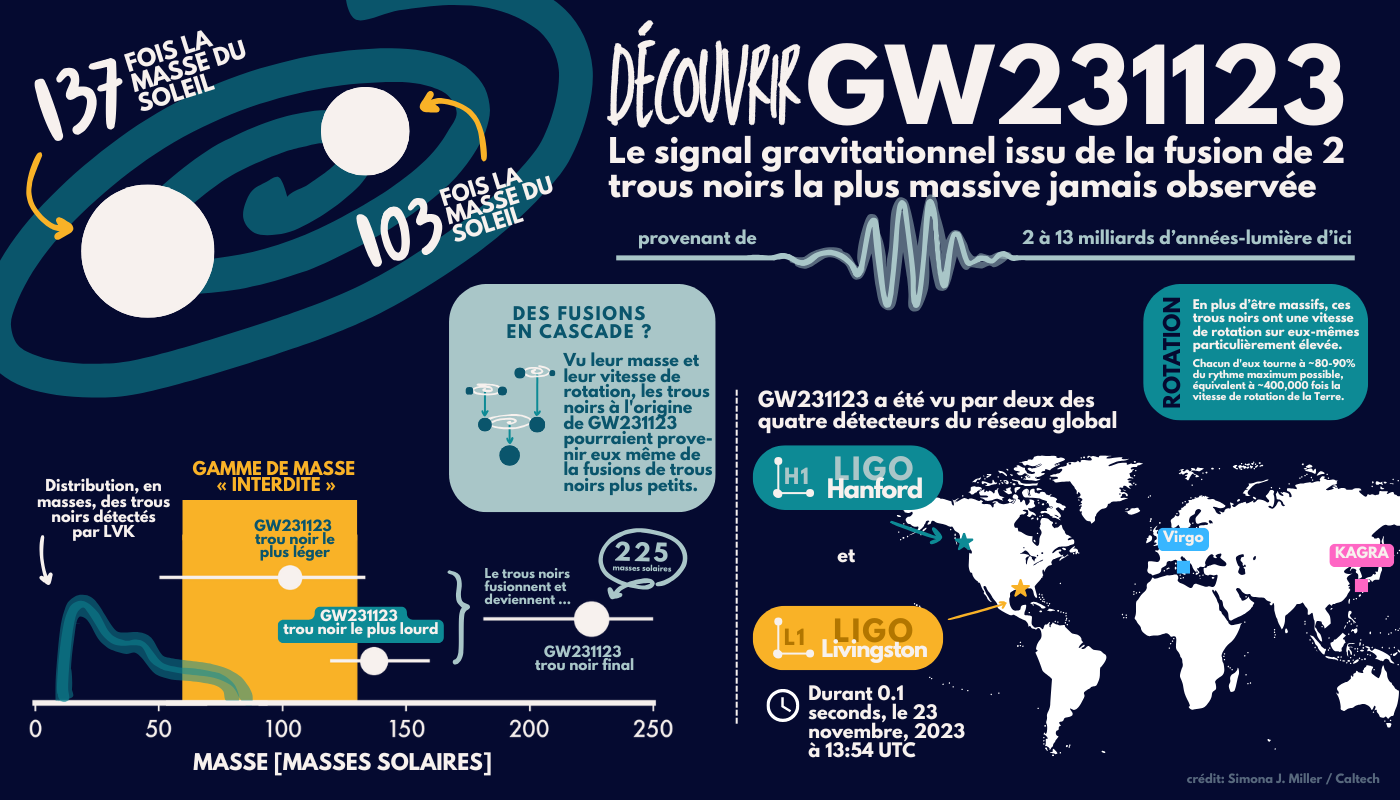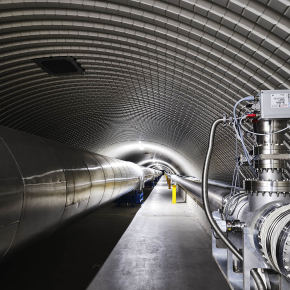LIGO-Virgo-KAGRA collaborations detect the most massive black hole merger ever observed
The gravitational waves emitted by these massive black holes challenge current astrophysical models.
The LIGO-Virgo-KAGRA (LVK) collaboration has announced the detection of the merger of the most massive black holes ever observed through gravitational waves, thanks to the LIGO Hanford and Livingston observatories, funded by the US National Science Foundation. The merger produced a final black hole with a mass 225 times greater than that of our sun. The signal, called GW231123, was observed during the fourth data-taking run of the LIGO-Virgo-KAGRA network (O4) on 23 November 2023.
The two black holes that merged had masses of nearly 103 and 137 solar masses, respectively. In addition to their high masses, they are also rapidly rotating, which made the gravitational wave signal particularly difficult to interpret and suggests that these black holes have a complex formation history.
‘The discovery of such a massive system with very rapidly rotating black holes represents a challenge for our analysis techniques,’ explains Ed Porter, a researcher at the APC laboratory in Paris (CNRS/Université Paris Cité). "It will also have a major impact on theoretical studies of black hole formation mechanisms and on the modelling of gravitational waveforms for many years to come. Indeed, current models of stellar evolution cannot explain the existence of such massive black holes, which could have formed as a result of previous mergers of lighter black holes."
Around a hundred black hole mergers have already been observed thanks to gravitational waves. Until now, the most massive binary system was the source of the GW190521 signal, with a much lower total mass of ‘only’ 140 times that of the Sun.
Exploring the frontiers of gravitational wave astronomy
The high mass and extremely rapid rotation of the black holes in GW231123 push the limits of current gravitational wave detection techniques and theoretical models. Extracting accurate information from the signal required the use of specific models that take into account the complex dynamics of rapidly rotating black holes.
‘This event pushes our instruments and data analysis capabilities to the limits of what is currently possible,’ explains Sophie Bini, a researcher at Caltech (USA). ‘It is a striking example of how much we can learn from gravitational wave astronomy, but also how much remains to be discovered.’
Gravitational wave detectors such as LIGO in the United States, Virgo in Italy and KAGRA in Japan are designed to measure the tiny distortions in space-time caused by violent cosmic events such as black hole mergers. The fourth observation campaign began in May 2023, and observations from the first half of the campaign (until January 2024) will be published in the summer of 2025.
‘The fourth LIGO-Virgo-KAGRA observation campaign, the longest ever conducted and using detectors with increased sensitivity, provides invaluable new insights into our understanding of the universe,’ says Viola Sordini, a researcher at IP2I (CNRS/University of Lyon 1) and deputy spokesperson for the Virgo collaboration. This exciting discovery heralds a new wave of results that will be revealed throughout the summer and will generate a continuous stream of discoveries over the next two years. After publication of the results, the data will be made public for use by the entire scientific community and to promote open science."
The results of the GW231123 signal study are being presented at the 24th International Conference on General Relativity and Gravitation and the 16th Edoardo Amaldi Conference on Gravitational Waves, held jointly in Glasgow, United Kingdom, from 14 to 18 July 2025.

About the LIGO-Virgo-KAGRA collaboration
LIGO is funded by the NSF and operated by Caltech and MIT, which designed and built the project. Financial support for the American Advanced LIGO project was provided by the NSF, Germany (Max Planck Society), the United Kingdom (Science and Technology Facilities Council) and Australia (Australian Research Council), which made significant contributions to the project. More than 1,600 scientists from around the world are participating in the effort through the LIGO Scientific Collaboration, which includes the European GEO Collaboration. A list of other partners is available at: https://my.ligo.org/census.php.
The Virgo Collaboration currently consists of approximately 1,000 members from 175 institutions in 20 different countries (mainly European). The European Gravitational Observatory (EGO) hosts the Virgo detector near Pisa, Italy, and is funded by the National Centre for Scientific Research (CNRS) in France, the National Institute for Nuclear Physics (INFN) in Italy, the National Institute for Subatomic Physics (Nikhef) in the Netherlands, the Research Foundation Flanders (FWO) and the Belgian Fund for Scientific Research (F.R.S.-FNRS). Further information is available on the Virgo website at: https://www.virgo-gw.eu.
KAGRA is a laser interferometer with a 3 km arm length located in Kamioka, in Gifu Prefecture, Japan. It is managed by the Institute for Cosmic Ray Research (ICRR) at the University of Tokyo. and the project is co-organised by the National Astronomical Observatory of Japan (NAOJ) and the High Energy Accelerator Research Organisation (KEK). The KAGRA collaboration consists of more than 400 members from 128 institutes in 17 countries/regions. Information about KAGRA for the general public is available on the website https://gwcenter.icrr.u-tokyo.ac.jp/en. Resources for researchers are accessible via this link http://gwwiki.icrr.u-tokyo.ac.jp/JGWwiki/KAGRA.
